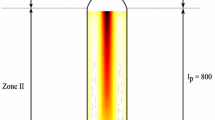Abstract
This third part of the study deals with the time-dependent nature of vortex breakdown. The results show the unsteady velocity and vorticity field of the initiation and development of breakdown and transition between both predominant breakdown modes, the bubble and the spiral. During the development to breakdown, the generated amount of circumferential vorticity follows the theoretical prediction by Brown and Lopez (1990). This confirms the idea of positive feedback as the key-mechanism leading to vortex breakdown. We regard the bubble-type as the fundamental breakdown type, that is stationary and nearly axisymmetric. The circumferential vorticity is distributed in a form of an elliptical vortex-ring-like structure. Starting from this stage, an increase of volume flux to a higher Reynolds number leads to the transition to the spiral-type with an initial stretching of the vortex ring-like structure and a subsequent change to an asymmetric circumferential vorticity distribution. This in combination with the inductive effect causes the front stagnation point to be deflected radially away and later to rotate around the centerline. Consequently the approaching vortex core is radially deflected in opposite direction and evolves in a spiral path. The idea of a second positive feedback-mechanism gives a possible explanation for the transition. Following this theory the asymmetry of circumferential vorticity will trigger itself at a certain degree by the interaction with the inductively affected stagnation point and its influence on the approaching vortex core. This self-enhancing process will finally lead to the spiral-type breakdown in which the radial distance between rotating stagnation point and deflected vortex core is of the order of the characteristic vortex core radius. The reversed transition from the spiral to a stable bubble-type can be regenerated by decreasing the Reynolds number down to the value that corresponds to the stable bubble state. The flow structure evolves nearly in the time-reversed way as during transition from bubble towards the spiral.
Similar content being viewed by others
References
Althaus W; Brücker Ch; Weimer M (1994) Breakdown of slender vortices. To be published in: Fluid Vortices (ed. S.I. Green) Kluwer Academic Publishing, Netherlands
Breuer M (1991) Numerische Lösung der Navier-Stokes Gleichungen für dreidimensionale inkompressible instationäre Strömungen zur Simulation des Wirbelaufplatzens. PhD thesis, RWTH Aachen, Germany
Brown GL; Lopez JM (1990) Axisymmetric vortex breakdown. Part 2: Physical mechanism J Fluid Mech 221: 553–576
Brücker Ch; Althaus W (1992) Study of vortex breakdown by particle tracking velocimetry (PTV). Part 1: Bubble-type vortex breakdown. Exp Fluids 13: 339–349
Brücker Ch (1993a) Study of vortex breakdown by particle tracking velocimetry (PTV). Part 2: Spiral-type vortex breakdown. Exp Fluids 14: 133–139
Brücker Ch (1993b) Experimentelle Untersuchung des Wirbelaufplatzens in Rohren mit der Particle-Image-Velocimetry (PIV). PhD thesis, RWTH Aachen June 1993, Verlag Shaker Germany
Dallmann U (1985) On the formation of three-dimensional vortex flow structures. Internal report 221–85 A13, DFVLR-AVA Göttingen, Germany
Escudier MP; Keller JJ (1985) Essential aspects of vortex breakdown. Proc Colloquium on Vortex Breakdown, 119–144, Feb. 11–12, 1985, Sonderforschungsbereich 25, “Wirbelströmungen in der Flugtechnik”, RWTH Aachen, Germany
Escudier MP (1988) Vortex Breakdown: Observations and Explanations. Prog. Aerospace Science 25: 189–229
Hall HG (1967) A new approach to vortex breakdown. Proc Heat Transfer Fluid Mech: 319–340, Stanford Univ. Press
Kobayashi T; Saga T (1988) A real-time velocity measurement algorithm for two-dimensional flow fields. 2nd Int Symp Fluid-control, measurements and flow visualization, Sept. 5–9, Sheffield, England
Krause E (1983) A contribution to the problem of vortex breakdown. AGARD-CCP-342
Krause E (1990) The solution to the problem of vortex breakdown. Lecture Notes in Physics 371: 35–50
Leibovich S (1978) The structure of vortex breakdown. Ann Rev Fluid Mech 10: 221–246
Leibovich S; Stewartson K (1983) A sufficient condition for the instability of columnar vortices. J Fluid Mech 126: 335–356
Lugt HJ; Gorski JJ (1988) The “Bubble” concept of axisymmetric vortex breakdown with and without obstacles in the vortex core. David Taylor Research Center, Report Nr. DTRC-88/042, Bethesda, Maryland
Sarpkaya T (1971) On Stationary and travelling vortex breakdowns. J Fluid Mech 45: 545–559
Sarpkaya T (1974) Effect of adverse pressure gradient on vortex breakdown. AIAA J 12: 602–607
Shi XG (1983) Numerische Simulation des Aufplatzens von Wirbeln. PhD thesis, RWTH Aachen, Germany
Spall RE; Gatski TB; Ash RL (1991) The structure and dynamics of bubble-type vortex breakdown. Proc Roy Soc London A 429: 613–637
Suematsu Y; Ito T; Hayase T (1986) Vortex Breakdown in a circular pipe. Bulletin of JSME 29(258): 4122–4129
Towfighi J; Rockwell D (1993) Instantaneous structure of vortex breakdown on a pitching delta wing. AIAA J 31: 1160–1162
Author information
Authors and Affiliations
Rights and permissions
About this article
Cite this article
Brücker, C., Althaus, W. Study of vortex breakdown by particle tracking velocimetry (PTV) Part 3: Time-dependent structure and development of breakdown-modes. Experiments in Fluids 18, 174–186 (1995). https://doi.org/10.1007/BF00230262
Received:
Accepted:
Issue Date:
DOI: https://doi.org/10.1007/BF00230262




